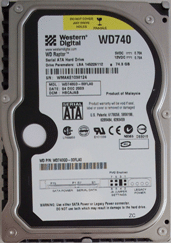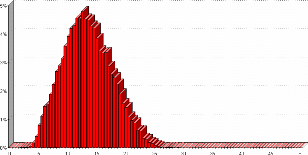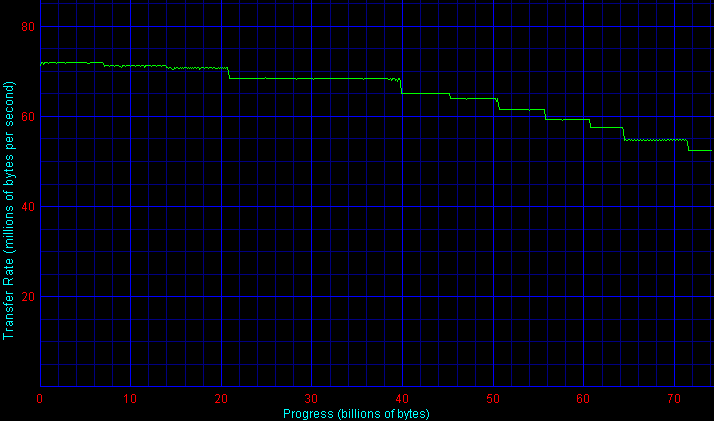Note: The article has been updated and given additional resources on 11/14/2011. Since the publication of this review, this drive has been retested under Testbed4, a newer hardware/software/benchmark platform. This review remains for reference purposes only.
Update 4/6/10 – Western Digital VelociRaptor 600GB Review
|
 For more information on the drive’s specs and performance potential, please review SR’s Western Digital Raptor WD740GD Preview.
For more information on the drive’s specs and performance potential, please review SR’s Western Digital Raptor WD740GD Preview.
The WD740GD hit general availability in mid-December. Though it took much longer than hoped, the firm has finally supplied SR with production samples. This newest Raptor features a 10,000 RPM spindle speed, two 37 GB platters, a 4.5 millisecond advertised seek time, an 8-megabyte buffer, and a 5-year warranty.
Though the product itself features firmware-level tagged command queuing, at the time of this writing, no appropriate controllers were available from several likely manufacturers. TCQ will likely bring significantly better performance scaling as multi-user loads increase; as of now, however, it remains a future promise. This initial review features the Raptor operating with a Promise SATA150TX4 controller.

In the following tests, the Western Digital Raptor WD740GD will be compared against the following drives for the following reasons:
| Western Digital Raptor WD740GD Beta Sample | The sample previously reviewed by SR |
| Western Digital Raptor WD360GD | The review unit’s predecessor |
| Maxtor Atlas 10k IV | Current-generation 10k RPM SCSI drive |
| Fujitsu MAP3147 | Current-generation 10k RPM SCSI drive |
| Seagate Cheetah 10K.6 | Current-generation 10k RPM SCSI drive |
| IBM Ultrastar 146Z10 | Current-generation 10k RPM SCSI drive |
| Maxtor Atlas 15k | The reigning champion for single-user performance |
| Hitachi Deskstar 7K250 | The fastest 7200 RPM SATA drive currently available |
| Western Digital Caviar WD2500JD | Western Digital’s current 7200 RPM SATA drive |
Low-Level ResultsFor diagnostic purposes only, StorageReview measures the following low-level parameters: Average Read Access Time– An average of 25,000 random accesses of a single sector each conducted through IPEAK SPT’s AnalyzeDisk suite. The high sample size permits a much more accurate reading than most typical benchmarks deliver and provides an excellent figure with which one may contrast the claimed access time (claimed seek time + the drive spindle speed’s average rotational latency) provided by manufacturers. WB99 Disk/Read Transfer Rate – Begin– The sequential transfer rate attained by the outermost zones in the hard disk. The figure typically represents the highest sustained transfer rate a drive delivers. WB99 Disk/Read Transfer Rate – End– The sequential transfer rate attained by the innermost zones in the hard disk. The figure typically represents the lowest sustained transfer rate a drive delivers. |
For more information, please click here.
|
Note: Scores on top are better.
|
|
||
WD740GD Average Read Service Time |
||
|---|---|---|
The Raptor WD740GD delivers a measured average access time of 7.8 milliseconds. Subtracting 3 ms to account for the rotational latency of a 10,000 RPM spindle uncovers a measured seek time of 4.8 milliseconds. As a result, the final sample manages to shave half a millisecond off of the score delivered by the pre-release unit. The WD740GD’s actual seek time weighs in about 0.3 milliseconds higher than Western Digital’s claim- off, but still quite close, especially for WD’s frequently optimistic figures.
|
Note: Scores on top are better.
|
|
|||||||||||||||||||||||||||||||||||||||||||||||||||||||||||||||
|
|
||||||||||||||||||||||||||||||||||||||||||||||||||||||||||||||
WD740GD Transfer Rate |
|||||||||||||||||||||||||||||||||||||||||||||||||||||||||||||||
Transfer rates more or less hold steady between the two samples. The outer- and inner-zone scores of the WD740GD rest at 71.8 MB/sec and 53.8 MB/sec respectively. This half-percent difference when contrasted with the beta unit’s scores falls well within WinBench 99’s margin of error; such differences can arise in a comparison of otherwise identical disks.
Single-User PerformanceStorageReview uses the following tests to assess non-server use: StorageReview.com Office DriveMark 2002– A capture of 30 minutes of actual computer productivity use that exactingly recreates a typical office-style multitasking environment. The applications include: Outlook XP, Word XP, Excel XP, PowerPoint XP, Calypso (a freeware e-mail client), SecureCRT v3.3 (a telnet/SSH client), CuteFTP Pro v1.0 (an FTP/SSH client), ICQ 2000b), Palm Hotsync 4.0, Gravity 2.3 (a Usenet/newsgroups client), PaintShop Pro v7.0, Media Player v8 for the occasional MP3, and Internet Explorer 6.0. StorageReview.com High-End DriveMark 2002– A capture of VeriTest’s Content Creation Winstone 2001 suite. Applications include Adobe Photoshop v5.5, Adobe Premiere v5.1, Macromedia Director v8.0, Macromedia Dreamweaver v3.0, Netscape Navigator v4.73, and Sonic Foundry Sound Forge v4.5. Unlike typical productivity applications, high-end audio- and video- editing programs are run in a more serial and less multitasked manner. The High-End DriveMark includes significantly more sequential transfers and write (as opposed to read) operations. |
StorageReview.com Bootup DriveMark 2002– A capture of the rather unusual Windows XP bootup process. Windows XP’s boot procedure involves significantly different access patterns and queue depths than those found in other disk accesses. This test recreates Windows XP’s bootup from the initial bootstrap load all the way to initialization and loading of the following memory-resident utilities: Dimension4 (a time synchronizer), Norton Antivirus 2002 AutoProtect, Palm Hotsync v4.0, and ICQ 2000b.
StorageReview.com Gaming DriveMark 2002– A weighted average of the disk accesses featured in five popular PC games: Lionhead’s Black & White v1.1, Valve’s Half-Life: Counterstrike v1.3, Blizzard’s Diablo 2: Lord of Destruction v1.09b, Maxis’s The Sims: House Party v1.0, and Epic’s Unreal Tournament v4.36. Games, of course, are not multitasked- all five titles were run in a serial fashion featuring approximately half an hour of play time per game.
For more information, please click here.
|
Note: Scores on top are better.
|
|
|||||||||||||||||||||||||||||||||||||||||||||||||||||||||||||||
|
|
||||||||||||||||||||||||||||||||||||||||||||||||||||||||||||||
|
|
||||||||||||||||||||||||||||||||||||||||||||||||||||||||||||||
Incredibly, the final version of the Raptor WD740GD manages to squeeze out even more performance in the StorageReview Desktop DriveMarks.
The Raptor delivers 606 I/Os per second in the Office DriveMark 2002, an improvement of about 5% over the pre-release unit’s score. The WD740GD as a result pulls within 3% of Maxtor’s mighty Atlas 15k, a drive that’s held the top single-user performance slot for nearly a year.
Remember, though the High-End DriveMark 2002 places slightly more emphasis on sequential transfers, the locality patterns that dominate single-user performance remain. The release Raptor musters a 3% improvement over the beta unit. Its score of 585 I/Os per second shatters previous records and trounces that of the Atlas 15k’s by an impressive 14% margin.
StorageReview’s Bootup DriveMark 2002 generates higher-than-normal queue depths through playback of Windows XP’s highly-tuned boot process. The Raptor manages 610 I/Os per second, again breaking all previous marks and leaving the Atlas 15k behind with a substantial 21% lead.
The WD740GD’s 749 I/Os per second in the Gaming DriveMark 2002 are not quite enough to surpass the Atlas 15k’s category-leading score. Still, by trailing the 15,000 RPM SCSI beast by just 6%, WD’s drive manages a formidable showing nonetheless.
Multi-User PerformanceStorageReview uses the following tests to assess server performance: StorageReview.com File Server DriveMark 2002– A mix of synthetically-created reads and writes through IOMeter that attempts to model the heavily random access that a dedicated file server experiences. Individual tests are run under loads with 1 I/O, 4 I/Os, 16 I/Os, and 64 I/Os outstanding. The Server DriveMark is a convenient at-a-glance figure derived from the weighted average of results obtained from the four different loads. StorageReview.com Web Server DriveMark 2002– A mix of synthetically-created reads through IOMeter that attempts to model the heavily random access that a dedicated web server experiences. Individual tests are run under loads with 1 I/O, 4 I/Os, 16 I/Os, and 64 I/Os outstanding. The Server DriveMark is a convenient at-a-glance figure derived from the weighted average of results obtained from the four different loads. For more information click here. |
|
Note: Scores on top are better.
|
|
|||||||||||||||||||||||||||||||||||||||||||||||||||||||||||||||
|
|
||||||||||||||||||||||||||||||||||||||||||||||||||||||||||||||
A continued lack of available controllers that work in conjunction with the Raptor WD740GD’s command queuing allows today’s premiere SCSI contenders to turn the tables on WD’s newcomer in multi-user performance measures. The 15,000 RPM Atlas, for example, dusts the Raptor by a huge 65% margin in the File Server DriveMark 2002. Even Seagate’s Cheetah 10K.6, considered a relatively conservative (but steady) workhorse, maintains a lead of 21% over the WD740GD.
The File Server DriveMark is actually a weighted average of individual scores at varying queue depths. Let’s take a closer look at the breakdown between the Raptor and similar 10,000 RPM SCSI units:
| Drive | 1 I/O | 4 I/Os | 16 I/Os | 64 I/Os |
|---|---|---|---|---|
| Maxtor Atlas 10k IV | 127 | 183 | 242 | 280 |
| Fujitsu MAP3147 | 121 | 167 | 239 | 272 |
| Seagate Cheetah 10K.6 | 116 | 166 | 236 | 279 |
| Hitachi Ultrastar 146Z10 | 113 | 150 | 209 | 257 |
| Western Digital Raptor WD740GD | 132 | 139 | 169 | 188 |
Western Digital’s offering delivers a seek time just as low as that of the competition. With just a single I/O operation outstanding, the Raptor leads the pack. As loads grow progressively heavier, however, the lack of a controller to pair with the Raptor’s firmware-level command queuing prevents its scores from scaling as elegantly as the SCSI competition.
The end result is similar in the Web Server DriveMark 2002: despite its great random access time, the Raptor simply can’t keep up.
Further breakdown of the Server DriveMarks under individual I/O loads may be found, as always, in the StorageReview Drive Performance Database.
Legacy PerformanceeTesting Lab’s WinBench 99 Disk WinMark tests are benchmarks that attempt to measure desktop performance through a rather dated recording of high-level applications. Despite their age, the Disk WinMarks are somewhat of an industry standard. The following results serve only as a reference; SR does not factor them into final judgments and recommends that readers do the same. |
|
Note: Scores on top are better.
|
|
|||||||||||||||||||||||||||||||||||||||||||||||||||||||||||||||
|
|
||||||||||||||||||||||||||||||||||||||||||||||||||||||||||||||
Heat and NoiseIdle Noise– The sound pressure emitted from a drive measured at a distance of 18 millimeters. The close-field measurement allows for increased resolution between drive sound pressures and eliminates interactions from outside environmental noise. Note that while the measurement is an A-weighted decibel score that weighs frequencies in proportion to human ear sensitivity, a low score does not necessarily predict whether or not a drive will exhibit a high-pitch whine that some may find intrusive. Conversely, a high score does not necessarily indicate that the drive exhibits an intrusive noise envelope. Net Drive Temperature– The highest temperature recorded from a 16-point sample of a drive’s top plate after it has been under heavy load for 80 minutes. The figures provided are net temperatures representing the difference between the measured drive temperature and ambient temperature. For more information, please click here. |
|
Note: Scores on top are better.
|
|
||||||||||||||||||||||||||||||||||||||||||||||||||||||||||||
|
|
|||||||||||||||||||||||||||||||||||||||||||||||||||||||||||
At idle, the Raptor WD740GD turns in an objectively-measured sound pressure of 42.3 dB/A from a distance of 18 millimeters, a 1.6 dB/A increase over the noise generated by the pre-release sample. This discrepancy, however, stands as yet another example of the perils one faces when judging a drive’s noise profile based on a single number. Subjectively speaking, the WD740GD’s idle noise remains virtually identical to the beta drive’s- that is, whisper quiet. The Raptor competes with 7200 RPM and even 5400 RPM drives as one of the quietest drives ever.
In the WD740GD preview article, I stated that “Despite the powerful actuator necessary to deliver sub-9ms access times, the WD740GD’s seek noises remain impressively muted. Even with a full random seek test running, the Raptor’s noise weighs in only slightly audible over our testbed’s Antec PP412X power supply and retail P4 heatsink fan.”
After subsequently living with the drive for two months in my own personal system, however, I have to retract the statement. When the drive is fairly busy, seek noises are distinctly audible over my machine’s power supply and CPU fans and are similar to the noises generated by that of 10k RPM SCSI devices. Personally, such sounds don’t bother me; indeed, like many others, I prefer to hear my drive when its actively retrieving data. Those who do not, however, should keep in mind that the drive’s actuator is a bit louder than that of today’s 7200 RPM ATA drives.
Despite the slightly swifter seeks, the final WD740GD generates an amount of heat similar to the pre-release sample and rests somewhere between the hottest 7200 RPM ATA drives and the coolest 4-platter, 10K RPM SCSI disks. Care must be taken to ensure adequate cooling and ventilation when installing the Raptor. Considering the drive’s target market of enthusiasts and servers, however, this should not be a problem.
ReliabilityThe StorageReview.com Reliability Survey aims to amalgamate individual reader experiences with various hard disks into a comprehensive warehouse of information from which meaningful results may be extracted. A multiple-layer filter sifts through collected data, silently omitting questionable results or results from questionable participants. A proprietary analysis engine then processes the qualified dataset. SR presents results to readers through a percentile ranking system. According to filtered and analyzed data collected from participating StorageReview.com readers, the Western Digital Raptor WD740GD is more reliable than of the other drives in the survey that meet a certain minimum floor of participation. |
According to filtered and analyzed data collected from participating StorageReview.com readers, a predecessor of the Western Digital Raptor WD740GD, the Western Digital Raptor WD360GD , is more reliable than of the other drives in the survey that meet a certain minimum floor of participation.
Note that the percentages in bold above may change as more information continues to be collected and analyzed. For more information, to input your experience with these and/or other drives, and to view comprehensive results, please visit the SR Drive Reliability Survey.
ConclusionDespite its announcement several years ago and the surrounding hoopla that ensued, the serial ATA interface remains in relative infancy, especially when contrasted to the tried and true SCSI bus. Though it was formally publicized over four months ago, the Raptor WD740GD still lacks accompanying controllers that would presumably elevate it to competitive status in server applications through the enabling of tagged command queuing. Thus, those seeking a drive for a server that routinely exceeds light to medium loads should remain focused on more mature, proven SCSI solutions. |
Ironically, despite the inclusion of command queuing and the associated promise of better multi-user performance, the WD740GD follows in the footsteps of its predecessor. The WD360GD won over many fans in the enthusiast/gaming community thanks to its outstanding single-user performance. Western Digital’s newest entry shatters previous records by even more astonishing margins. In addition to leaving all other 10k RPM SCSI drives in the dust, the WD740GD approaches the performance of the 15k RPM Fujitsu MAS3735 and Maxtor Atlas 15k in the Office and Gaming DriveMarks. Further, it handily bests the two powerhouses in the High-End and Bootup DriveMarks. Overall, for non-server use, Western Digital’s Raptor WD740GD is the fastest single hard disk one can buy regardless of spindle speed, interface, or price. The fact that it is so quiet, runs much cooler, and remains significantly less expensive than its SCSI counterparts is simply icing on the cake. Make no mistake about it- the Raptor WD740GD is the drive for power users, period.




 Amazon
Amazon